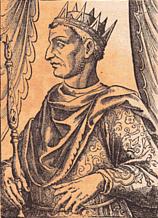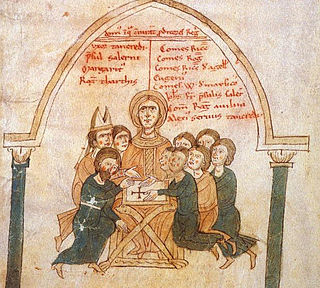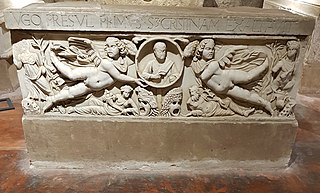Richard Palmer, an Englishman, was the bishop of Syracuse from 1169 and archbishop of Messina from 1182. Palmer first rose to prominence in 1160 as one of the triumvirate of grandees who replaced the assassinated Admiral Maio of Bari. He was "a man of great learning and eloquence," according to Hugo Falcandus.
On the death of Bishop Rinaldo de Lusio in 1154, Palmer was elected bishop of Syracuse, but he was not consecrated until 1169. On Saturday 11 March 1161, he joined with three other great ecclesiastics of the kingdom— Romuald II, Archbishop of Salerno; Robert, Archbishop of Messina; and Tristan, Bishop of Mazara —to incite the people of Palermo to rise against the rebels led by Matthew Bonnellus and free the royal family.
In 1162, Sylvester of Marsico died and Henry Aristippus was disgraced, thus Palmer was the only member of the original triumvirate left in power. The replacements, Matthew of Ajello and the caïd Peter, remained in power until the death of King William I in 1166. They automatically became the chief advisors of the regent, the queen mother Margaret of Navarre. Margaret, however, distrusted Palmer and Matthew and appointed the caïd above them, greatly disaffecting the two. Palmer joined Gilbert, Count of Gravina, cousin of the queen, in open opposition to the eunuch.
At that time, Palmer was a candidate for the vacant archdiocese of Palermo, as were his fellow bishops: Tristan of Mazara, Roger, Archbishop of Reggio, and Gentile, Bishop of Agrigento. However, Margaret further ostracised the court by securing the consecration of Stephen du Perche, her own cousin, as archbishop (1167). Of all the ecclesiastical contenders, Palmer was most infuriated. The next year (1168), however, a rebellion led by Henry, Count of Montescaglioso, a brother to the queen, toppled the new archbishop and forced him to flee. Palmer was a guarantor of the outgoing Stephen's safety.
With Stephen gone a council was set up to assist Margaret. It included not only Palmer, but Romuald of Salerno, Gentile of Agrigento, John, Bishop of Malta, Matthew of Ajello, the new caïd Richard, Henry of Montescaglioso, Counts Richard of Molise and Roger of Geraci, and Walter of the Mill, a fellow Englishman who would eventually take up the Palermitan see so coveted of Palmer. Palmer had opposed Stephen and he opposed Walter, too. He joined the queen, not in writing to Pope Alexander III, but to Thomas Becket, who wrote back:
- There is one other request, which I will whisper in your ear and which I hope you will grant me; and that is that you would do your utmost with the King and Queen to obtain the recall to Sicily of that noble man Stephen, Elect of Palermo; for reasons which shall at present be nameless and also because by doing so you will earn the lasting gratitude of the King of France and his entire Realm.
Clearly, Becket was unaware of Palmer's deep dislike of Stephen. Palmer was to become estranged from Becket in the near future, however. In 1170, Palmer and Robert of Loritello went to discuss the marriage of the young king with Joanna, daughter of Henry II of England. According to Becket, then at odds with Henry (odds that famously soon killed him), Palmer was enticed to the king's side by an offer of the bishopric of Lincoln. However, Palmer had recently been consecrated by the pope himself with the pallium and raised to metropolitan status: an offer of Lincoln, in England, would probably not have wooed him. After the betrothal was confirmed, Palmer and Alfano, Archbishop of Capua, travelled to Saint Gilles to receive Joanna and accompany her to Sicily.
In 1182, Palmer was transferred to the see of Messina. In 1190, he was part of a delegation along with the archbishops of Monreale and Reggio, Margaritus of Brindisi, and the strategos of Messina, Jordan du Pin, who failed in negotiations with Richard the Lion-Hearted. Palmer died soon after.
Palmer had tried but could not convince Peter of Blois to return to Sicily. Palmer was responsible for the glass and mosaics of Syracuse Cathedral. His tombe survives in the Cathedral of Messina, almost intact.

William I, called the Bad or the Wicked, was the second king of Sicily, ruling from his father's death in 1154 to his own in 1166. He was the fourth son of Roger II and Elvira of Castile.

William II, called the Good, was king of Sicily from 1166 to 1189. From surviving sources William's character is indistinct. Lacking in military enterprise, secluded and pleasure-loving, he seldom emerged from his palace life at Palermo. Yet his reign is marked by an ambitious foreign policy and a vigorous diplomacy. Champion of the papacy and in secret league with the Lombard cities, he was able to defy the common enemy, Frederick Barbarossa. In the Divine Comedy, Dante places William II in Paradise. He is also referred to in Boccaccio's Decameron.

Margaret of Navarre was Queen of Sicily as the wife of William I (1154–1166) and the regent during the minority of her son, William II.

Maio of Bari was the third of the great admirals of Sicily and the most important man in the Norman kingdom of Sicily during the reign of William I (1154–66). Lord Norwich calls him "one of the most influential statesmen in Europe."
Stephen du Perche was the chancellor of the Kingdom of Sicily (1166–68) and Archbishop of Palermo (1167–68) during the early regency of his cousin, the queen dowager Margaret of Navarre (1166–71).

Nicholas of Ajello was the second son of the Sicilian chancellor Matthew of Ajello and the archbishop of Salerno from 1181, when he succeeded the historian Romuald Guarna. He was a trusted advisor in the Norman Kingdom of Sicily at the time of its fall to Henry VI, Holy Roman Emperor (1194).
Matthew of Ajello was a high-ranking member of the Norman court of the Kingdom of Sicily in the 12th century. His brother John was a bishop.
Matthew Bonnellus was a rich knight of an ancient and influential Norman family who became the lord of Caccamo in Sicily. He is most famous as the leader of three consecutive revolts against the ammiratus ammiratorum Maio of Bari and King William I of Sicily.

Henry, born Rodrigo according to Hugo Falcandus, was an alleged son of the Navarrese king García Ramírez and his wife, Margaret of L'Aigle, and brother of the Sicilian queen dowager Margaret, who made him Count of Montescaglioso (1166) and then Prince of Taranto (1168).
Walter Ophamil or Offamil, italianised as Gualtiero Offamiglio or Offamilio from Latin Ophamilius, was the archdeacon of Cefalù, dean of Agrigento, and archbishop of Palermo (1168–1191), called "il primo ministro", the first minister of the crown. He came to Sicily with Peter of Blois and Stephen du Perche at the direction of Rotrou, Archbishop of Rouen, cousin of Queen Margaret of Navarre, originally as a tutor to the royal children of William I of Sicily and Margaret. His mother was Bona, a patron of the Abbey of Cluny and a devota et fidelis nostra of the king in 1172. His father is unknown. From his name he was long thought to be an Englishman but this interpretation is now rejected in favour of ophamilius referring to Walter as William II's protofamiliaris, the senior confidant of the king in his royal household, the familiaris regis.
Gilbert was a Norman Count of Gravina from 1159 until 1167. His father Bertrand was the illegitimate son of Rotrou III, Count of Perche. He was a cousin of Margaret of Navarre, the queen of Sicily. He arrived in Sicily sometime around 1159 and, through Margaret's influence, was created Count of Gravina in Apulia immediately.
Gentile was the bishop of Agrigento in Sicily from 1154 to his death. He has been described as a prélat aventureux et vagabond, an "adventurous and vagabond prelate".
Ahmed es-Sikeli, baptised a Christian under the name Peter, was a eunuch and kaid of the Diwan of the Kingdom of Sicily during the reign of William I. His story was recorded by his Christian contemporaries Romuald Guarna and Hugo Falcandus from Sicily and the Muslim historian Ibn Khaldun.

Sylvester, count of Marsico, was a Norman nobleman of the Kingdom of Sicily.
Henry Aristippus of Calabria, sometimes known as Enericus or Henricus Aristippus, was a religious scholar and the archdeacon of Catania and later chief familiaris of the triumvirate of familiares who replaced the admiral Maio of Bari as chief functionaries of the Kingdom of Sicily in 1161.
Richard the Qaid was a senior official of the royal council in the court of the Norman Kingdom of Sicily at Palermo during the latter years of the reign of William I of Sicily and during the regency of his wife, Margaret of Navarre, for their son William II. He was already the Great Chamberlain, or magister camerarius, when William I died in 1166.

Hugh was the Archbishop of Capua in the late 1140s and Archbishop of Palermo from 1150 until his death, probably in 1165–66.

The Diocese of Mazara del Vallo is a Latin diocese of the Catholic Church in far western Sicily. It is a suffragan of the Archdiocese of Palermo.

The Archdiocese of Siracusa, also known as Syracuse, is a Latin Church ecclesiastical territory or diocese of the Catholic Church in Sicily. It became an archdiocese in 1844. The current archbishop is Francesco Lomanto.
The Sicilian bishops' conference is a group of Bishops of the Roman Catholic Church in Sicily. These are the bishops of the 17 dioceses of the Church belong to the 5 provinces of the Church of Sicily, and the Eparch Piana degli Albanesi. The Sicilian bishops' conference is a part of the Italian Episcopal Conference. Some bishops who are in the Sicilian bishops 'conference delegates certain responsibilities belong to the Italian Bishops' Conference of the respective commissions.
 This article incorporates text from a publication now in the public domain : Herbermann, Charles, ed. (1913). "Archdiocese of Messina". Catholic Encyclopedia . New York: Robert Appleton Company.
This article incorporates text from a publication now in the public domain : Herbermann, Charles, ed. (1913). "Archdiocese of Messina". Catholic Encyclopedia . New York: Robert Appleton Company. This article incorporates text from a publication now in the public domain : Herbermann, Charles, ed. (1913). "Archdiocese of Syracuse". Catholic Encyclopedia . New York: Robert Appleton Company.
This article incorporates text from a publication now in the public domain : Herbermann, Charles, ed. (1913). "Archdiocese of Syracuse". Catholic Encyclopedia . New York: Robert Appleton Company.








